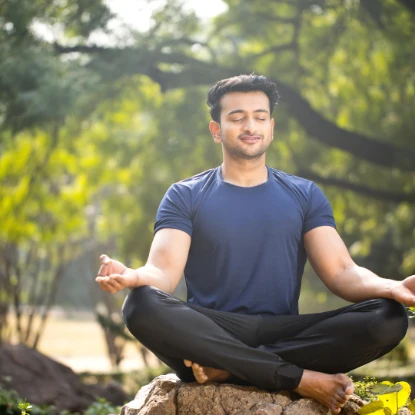February 17, 2024
Why Happiness Eludes Humans
Humans are born with an innate need to belong. As infants, we experience a feeling of oneness with our parents and close relatives, enveloped in unconditional love and acceptance. But as we grow older, we start to realize this acceptance now comes with conditions based on our behavior and actions. The recognition of this plants a seed of doubt and uncertainty about ourselves. Knowing we can now potentially feel unaccepted by those closest to us. No other living beings such as animals, experiences this type of conditional acceptance. It fragments our peace and sense of security.

In response, we start to form a self-image, an identity constructed from the traits and behaviors that garner us praise and acceptance. Rather than living as our natural selves, we shape ourselves into what we think others want us to be. This fabricated identity becomes our relentless obsession, consuming our attention and making us feel disconnected from the world as we direct our attention toward this self. We judge and compare ourselves to others, doubting our worth and competing to be superior to and more acceptable than others. We may achieve career success, material possessions, romance and admiration, but still feel something is missing. That deep sense of unconditional belonging still eludes us no matter what we gain or achieve. We are always checking our image against the judgments and standards of others.

Why is this? Because the roots of our suffering stem from when we first learned we could lose the love of those closest to us. Even if it wasn’t truly lost, just that momentary withdrawal of love was painful enough to make us want to avoid it. The image we created and now obsess over is an attempt to regain that lost acceptance. But it is just an image, not our true selves. No matter how much others may admire this fabricated identity, we remain unsatisfied because it is only the image they are accepting. So, we settle for acceptance of that image, giving up on acceptance of our true self, even, our own acceptance of it, and even our own recognition of it. We become like an actor on a stage, putting aside our true feelings for the sake of getting applause.
When you think about it, we tend to see everything and everybody as how they relate to this imagined self and make judgements according to that criteria. We can’t help but compare ourselves to others because this is how our imagined self looks for direction. This way of life steals our attention and peace of mind. It produces so many unnecessary emotions like fear, anxiety, competitiveness, depression and so much more because we are focused on the survival of something that we created in our mind rather than on our true nature which is real and unshakable. This is why lasting happiness seems to elude us.
Is There a Way to Lasting Happiness?
The solution is to stop giving our attention to the illusion of this imagined self, and reconnect with our original nature, our true selves. All our obsessive judgments about our personality, looks, success or failures are meaningless to our true self, as it is happy just to be, just to exist. This true essence exists beyond the transient identities and needs that we focus on.

When we stop chasing the mirage of our imagined selves and cease judging ourselves and others, we rediscover our innate perfection. We once again feel that boundless unconditional acceptance, not just for ourselves, but for other people as well. We no longer need to judge others once we stop judging ourselves. It is not something we have to strive for or develop, it already is there at our core once we let go of the things that are blocking us from seeing it. This state of enlightened consciousness has been taught by all the founders of religious traditions, and yet it remains so persistently elusive. The habitual patterns of self-judgment and identity with the imagined self are deeply ingrained.
How Meditation Brought Me to Lasting Happiness?
I started meditation because I always had a sense that there was something more to life than the way others and myself saw it. I had read the scriptures of most of the religions in search of how we should live. But in spite of gaining all this wisdom from great teachers, I couldn’t apply it to my life and it didn’t change the way I saw the world or my choices and actions. When I went to the first lecture about this meditation method, the meditation guide explained to me that it is not about knowing Truth, it is about becoming Truth.

This meditation provided a simple method for bringing up mental images that we hold in our minds as pictures, and releasing the hold they have on our mind. There are eight levels in this meditation. Each one is an ingenious method for clearing different aspects of this illusionary mind world. After practicing it for a short time, I began to feel freer as I started recognizing how many of my beliefs stemmed from particular pictures in my mind. As I progressed through the meditation levels, these images lost their grip on my worldview and sense of self. I grew more accepting of others. My family relationships improved as I began appreciating people as they were, rather than judging them against my standards.Gradually, my perspective became clearer. I saw that living for my own self-image was not only unnecessary but destructive to my happiness and the happiness of others.
As I continued to do the meditation I could see my imagined self as the delusion it is and began to see the world free of the limitations imposed by it. It felt like I was starting a new life, no longer playing the games of an imaginary self, and feeling free to appreciate and accept life and the world just as it is. There was no longer any need to compare myself to others because direction came from within myself. What I found was a world that was larger and more beautiful than I could have ever imagined because it was no longer limited by my conceptions. I was free of any anxieties, worries, and mental chatter or seeking distractions. I found myself being able to live every moment in a state of peace and attention. At first when all the usual worries disappeared, I thought to myself, am I being irresponsible by not worrying? The truth is, I was being more responsible and effective than ever because now I was living in a true state of mind and could act truthfully rather than acting out of false motivations and conceptions.
This change didn’t happen overnight. It took time and dedication. I could not have done it had it not been for the very experienced meditation guides and founders of the method that kept me on track. Once I got to the point that I could clearly see the difference between living for what’s true rather than living for what’s false, I realized that there is nothing more important than making that change.

Conclusion
Your search for happiness need not be a lifelong quest. The peace you seek is not found in the external world or in getting approval from the world. It lies quietly within you, waiting to be uncovered. You need only wake up from the trance of the false self to experience it. It may seem hard to believe but by following this simple meditation method you can be liberated from the self-made world of this illusory self. All the worries and stresses that are an inherent part of it disappear and only unconditional happiness and freedom remain. You can work with a clear mind, which makes it easy to succeed in whatever you do.




